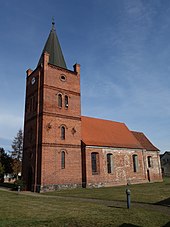Zollchow village church
The Protestant village church Zollchow is a late Romanesque brick church in the district Zollchow of the municipality Milower Land in the district Havelland in Brandenburg . It belongs to the parish of Milow in the Evangelical Church District Nauen-Rathenow of the Evangelical Church Berlin-Brandenburg-Silesian Upper Lusatia .
History and architecture
The Zollchow village church is essentially a late Romanesque brick hall with a retracted choir from the first half of the 13th century. It was renewed in the 18th century, with a polygonal choir closure added, the components brought to the same height and plastered and arched windows inserted. The western part of the ship and the square western tower with roof battlements were added after the fire in 1847-49 by the royal road builder Detto from Genthin. The original choir closure is unclear, as is the original shape of the western part of the nave; however, it is likely that the east end was built from demolition material and roughly corresponds in shape and size to that of the medieval east end.
On the south side, walled-up remains of the arched portal and windows have been preserved. On the north side of the choir there is also a late Romanesque gate to the sacristy, which has an oak door with iron band fittings. The interior is characterized by a round triumphal arch with a girder and fighters . Stepped round arched wall niches are arranged in the choir. A flat wooden ceiling plastered in the choir completes the interior. A gallery is arranged on the south and west sides.
Furnishing
The main piece of equipment is an altar structure with columns and rocaille cheeks from the second half of the 18th century, the paintings with Christ on the Mount of Olives and the Last Supper are copies after Jan Gossaert and Leonardo da Vinci . The wooden pulpit dates from the 18th century and shows carvings of foliage on the polygonal basket and on the steps; a small wooden relief of the Trinity from the mid-17th century is attached to the back wall . A late Gothic sandstone baptism is octagonal with a tendril frieze on the cup . An organ prospectus with rich Rococo decoration was created in 1764 by Gottlieb Scholtze from Neuruppin. The organ was built into the existing case by Friedrich Hermann Lütkemüller around 1850 and has nine stops on a manual and pedal . Four Scholtze registers have been adopted and are preserved. Three small wooden sculptures are also part of the furnishings: in the choir Madonna and Child from the third quarter of the 15th century and a seated Madonna from an Adoration of the Child from the second half of the 17th century and a Pietà from the first half of the 16th century.
A panel of the Crucifixion from the first half of the 18th century has survived; the painting shows the Madonna and Child in a copy after Bartolomé Esteban Murillo , probably from the second half of the 17th century. Two late medieval bells make the peal.
literature
- Georg Dehio : Handbook of the German art monuments. Brandenburg. Deutscher Kunstverlag, Munich / Berlin 2000, ISBN 3-422-03054-9 , p. 1170.
- Damian Kaufmann: The Romanesque brick village churches in the Altmark and Jerichower Land. Verlag Ludwig, Kiel 2010, ISBN 978-3-86935-018-9 , pp. 450–452.
Web links
Individual evidence
- ^ Damian Kaufmann: The Romanesque brick village churches in the Altmark and in the Jerichower Land. Verlag Ludwig, Kiel 2010, ISBN 978-3-86935-018-9 , p. 451.
- ↑ Information about the organ on orgbase.nl. Retrieved November 28, 2018 .
Coordinates: 52 ° 31 ′ 41.2 " N , 12 ° 12 ′ 33.7" E


